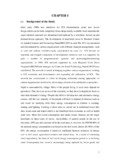Please use this identifier to cite or link to this item:
https://elibrary.tucl.edu.np/handle/123456789/2340| Title: | Improved Cooking Stove and its Impact on Women ( A Case Study of Thanapati VDC Ward No. 3, Nuwakot District ) |
| Authors: | Thapaliya, Karuna |
| Keywords: | Alternative energy;Cooking Stove;Nuwakot;Biomass;Biomass |
| Issue Date: | Jul-2011 |
| Publisher: | Central Department of Rural Development Tribhuvan University, Kathmandu |
| Abstract: | In nearly all developing countries biomass represents about 80% of the energy balance used for cooking purposes. This biomass is used in very inefficient stove and wasting alot of energy. This fact contributes to the continuing process of deforestation in developing countries. The sustainability is only achievable ifa fair profit for all actors of the production and disteribution chain is guaranteed. The present study site is situated in in Thanapati VDC, one out of the sixty one of the Nuwakot District in hill of central development region. It is situated in the North east side from the district headquarter. The study tries to show the impact of improved cooking stoves on women. It also focuses on the socio-economic, environmental and health impact on women and others as well. Use of traditional stoves such as “agenu” and “chulo” consumes more fuel woods and increases the burden on women. Women are mainly responsible for cooking and collection of bio-mass, mainly fuel wood from the forest. Use of biomass energy and low grade biomass fuels lead to excessive level of indoor smoke/air pollution. Women and children in particular are exposed to the smoke emission. This is one of the reasons for higher rate of infant mortality and morbidity and other unhealthy living conditions. Release of incomplete carbon gas and other harmful particles in the atmosphere due the poor combustion of biomass fuel in rudimentary stoves results the emission of green house gas. More then 80% of the energy needs are met by fuel wood thus exerting immense pressure on the forest resources of the country with negative impacts on environment. During the study both primary and secondary data have been used. Household survey, observation, interview , focus group discussion method were carried out to get primary data and both published and unpublished sources were used as a source of secondary data. Out of total households of 200, in ward 3, 20% of them have atken as sample of the study. The study shows that, 45% of the chhetri population have installed the ICS followed by Brahmins with 35%. The primary occupation of the study site is agriculture where 30.07% are engaged on it. 75% of the respondent said that the system is very usefull for the households. Because of growing population in developing countries and the inefficient use of biomass, the pressure on the forest resources become more and more crucial. More and more trees disappear for the landscape and are not replaced . Senegal loses for example every year some 45000 hectares of forest areas. Other fuels such as gas, petroleum or electricity are too expensive for the biggest part of households in while they are cooking . Dr. Marlis Kees from GTZ underline that improve stoves “ studies have showed that respiratory diseases by women and children can be reduced 50%”. This fact shows that th reductiom of smoke is as imporant as the reduction of biomass consumption. A stove with the same biomass consumption as a traditional one but with far less smoke can be considered to be an improved stove. In Nepal, women are mainly responsible for cooking activities and collecting firewood. With the decrease in the availabitlity of fuel wood, drudgery of women is increasing and they have to spend more time collecting fuel wood. Study have shown that ICS has efficiency of 15-25% and fuel wood saving is 30-35%. Thus, contributing in the drudgery reduction of women reducting their cooking time and hardship in collection of scarce fuel wood. Women are generally accompanied by their children in the kitchen and are expose to indoor air pollution. The indoor air pollution due to the combustion of biomass fuel is main cause of Acut Respiratory Infection(ARI), Chronic Obstructive Lung Diseases (COLD), Eye Infection and Pheumonia in women and children. Studies have shown that the use of ICS human exposure to pollutants in the kitchen environment has been reduced by an average of 69% carbon monoxide concentration. In a simpler term most of the women using ICS have respondended that they had Asthma and Eye Burning due to traditional stoves but the situation has improved after the installation of ICS and they have no complain of burning eyes and breathing problem. |
| URI: | http://elibrary.tucl.edu.np/handle/123456789/2340 |
| Appears in Collections: | Rural Development |
Files in This Item:
| File | Description | Size | Format | |
|---|---|---|---|---|
| Final Cover and Contents.pdf | 196.54 kB | Adobe PDF |  View/Open | |
| Final Thesis report ( ICS System).pdf | 1.46 MB | Adobe PDF |  View/Open |
Items in DSpace are protected by copyright, with all rights reserved, unless otherwise indicated.
